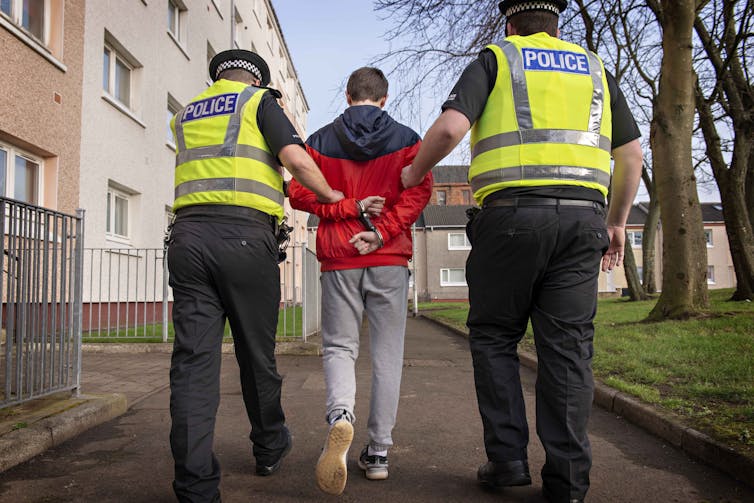How images of knives intended to stop youth knife crime may actually be making things worse

Nicole Kwiatkowski/Shutterstock
You’d be forgiven for thinking that young people are behind most knife crime in the UK. Media coverage often focuses on youth involvement, and the government’s plan to halve knife crime focuses specifically on young people and vulnerable teenagers.
Evidence shows that most knife-involved crime is committed in the home, between adults, in the form of intimate partner violence. Only around 18% of knife offences are carried out by 10- to 17-year-olds. These usually involve other young people.
Although young people’s share of knife crime is low, their involvement is a significant concern and has risen starkly in the last decade.
Choosing to carry a knife out of the home, into the streets, or into school is a rare choice that most children never make. Estimates show that between one and four in 100 young people carry knives.
For those few who do, it is important to understand the complex factors behind why. This is what we, and many other academics, have been studying in our research.
Both researchers and young people themselves cite protection as a factor in knife carrying. Many young people are fearful of being victims of knife crime, and knife carrying may offer a sense of security and defence from potential threats.
This fear is not necessarily correlated to reality. Young people tend to overestimate the prevalence of weapon carrying among their peers. What’s more, those carrying knives for defence often end up having their own knife used against them.
Seeing images of knives
One reason that young people may have a fear of knife crime is because of how the threat is presented to them through images.
Media reports and anti-knife campaign material often features images of shocking weapons, such as zombie knives. Depictions of piles of seized weapons and vicious blades all paint a picture of a risky landscape.
You probably noticed that the photos illustrating this article do not include a picture of a knife. This is a deliberate choice. Our research has found that such knife imagery can evoke fear or excitement for some young people.
Their heightened emotional responses suggest that these young people are the most likely to be vulnerable to future knife carrying. Those who feel most unsafe in their communities are the most likely to respond negatively to graphic imagery.
Interestingly, the young people who participated in our research self-reported knife imagery as having little impact on them. But our study investigated their unconscious emotional response through an implicit association test. This approach is key in a research area vulnerable to self-presentation bias, where young people might attempt to hide their true feelings.
The test we used assessed response speeds to determine associations between images of knives and words relating to fear and excitement. Overall, response times were faster (showed more association) for fear-related words.
Other evidence suggests that anti-knife crime imagery and messaging can create exaggerated belief about the prevalence of knife carrying. This may increase, rather than reduce, the fear of victimisation, and further encourage people to carry knives.

Some young people say they carry knives because they feel a need to protect themselves.
No Knives, Better Lives, © Open Aye, CC BY-NC
Floods of knife images in a young person’s social and educational environment may normalise knife carrying. Nearly two-thirds of young people report experiencing secondary traumatic stress when viewing knife crime news on social media.
When knife imagery is used in intervention materials presented by someone in a position of authority (a teacher or police officer, for example), it can validate the fears even more.
In other words, the more we talk about knife crime, the scarier it can seem, and the more young people feel the need to protect themselves by carrying a weapon.
Labour’s plan to cut knife crime – including a ban on zombie knives that has just come into effect – should go a long way to reducing the availability of “status” weapons. It may also mean that images of these knives are less prevalent in the media, which, given our research findings, would likely have a positive effect.
But, as noted earlier, most young people are not at risk, and have had no exposure to knife crime. Knife carrying is not normal behaviour for most young people. Anti-knife messaging would serve young people better by avoiding the use of knife imagery, and instead focus on discussing how to keep safe by avoiding risky behaviour, and how to get help if a dangerous situation arises.
![]()
Dr Charlotte Coleman receives funding from N8 Policing Research Partnership.
Dr Charlotte Coleman is a member of the Youth Justice Board Academic Liaison Network
Dr Charlotte Coleman is an executive member of the Society for Evidence Based Policing.
Jess Scott-Lewis does not work for, consult, own shares in or receive funding from any company or organisation that would benefit from this article, and has disclosed no relevant affiliations beyond their academic appointment.







